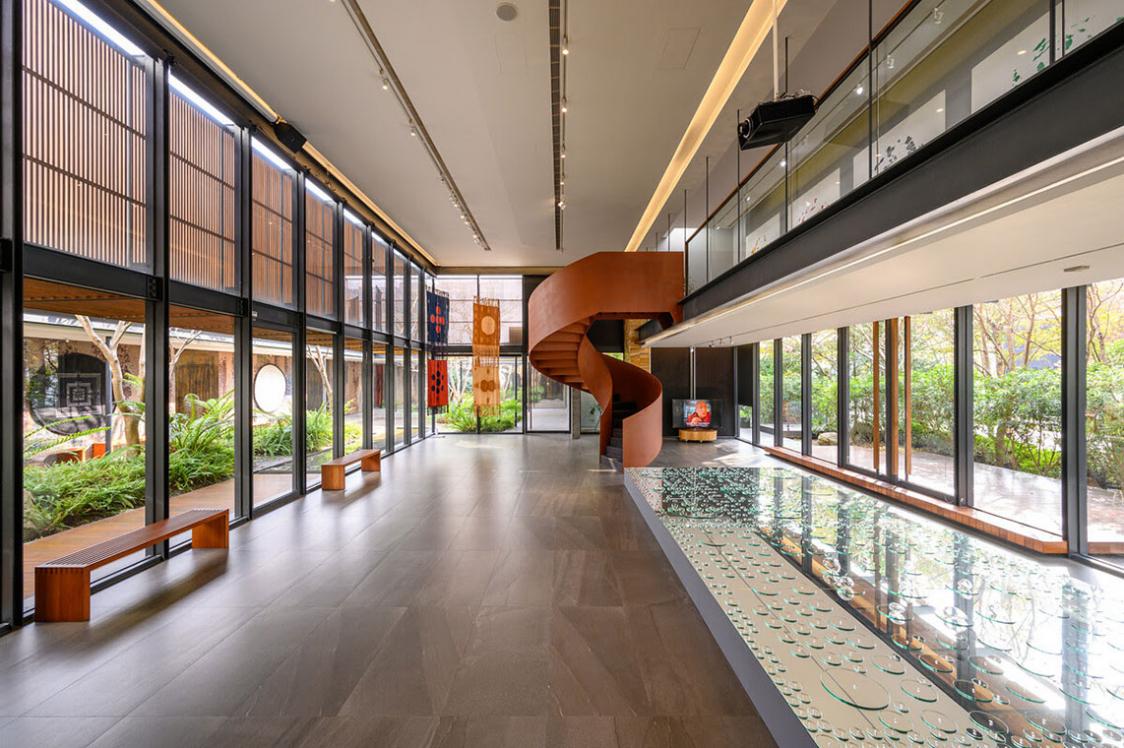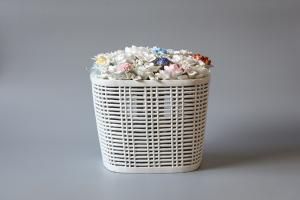CHARWEI TSAI: THE WOMB & THE DIAMOND
Live Forever Foundation, Taichung City / Taiwan
January 31–May 30, 2021
By Lily Tiger T Wells
The Womb & The Diamond Realm is Charwei Tsai’s recent solo-exhibition in Taiwan curated by Dr. Jau-Ian Guo at Vital Space and Art Corner at National Taichung Theatre in Taiwan. The exhibition comes following the Tapiei-based artist’s series of personal pilgrimages exploring the tradition of tantra across the trade routes from the Tang Dynasty.
Centre of the exhibition space is an enormous glass installation spanning six by three metres across the gallery space. Hand blown glass, circle mirrors and diamonds glimmer and reflect the passing clouds and natural sunlight drawn in from the expansive gallery windows. This is a piece created in reference to the Garbhadhatu (‘womb realm’) and Vajradhatu (‘diamond realm’) mandalas from the Shingon Buddhist temples in Mount Koya, Japan.
Over the past three years, her journey traced traditions from 5th century from 5th century India to medieval trade routes across western China, eastward to japan, southward to java and North to Mongolia. Using breath and sound, she voiced the one-syllable ‘Dependent Arising Mantra’, commonly recited during the dawn of a new journey to blow the individual glass pieces. Capturing the ephemeral mantras in fragile casings, they appear like beads of water scattered on the surface of glass as they are then laid on circular mirrors as part of the larger mandala. In an interview with Luise Guest, Tsai said “This project is again about the interdependence of form and emptiness. It also became a reflection on how our material world is driven by immaterial forces.”1
Visitors are also invited to take a flower petal and place it on the mandala, to honour the victims of the coronavirus pandemic thus creating a piece which will chance over the course of the exhibition. Similarly, Tsai will create another site-specific and durational piece by painting verses from the Flower Ornament Sutra with organic cinnabar extracted pigments in her meticulous style on rice paper. Upon completion, the mural will span one of the seven by five metre windows of the theatre. Staying true to the artist’s interest in the use of raw materials, ‘Five Sky Dancers’ will also be on display; a colourful series of drawings in azurite and malachite pigments, minerals found in the cave paintings along the sutras’ trade routes during the Tang Dynasty.
Tsai studied in the US at the Rhode Island School of Design, and later completed the postgraduate research program, at L’École Nationale Supérieure des Beaux-Arts in Paris. Her recent exhibitions include Human Rights Art Festival, Green Island, Taiwan (2020), Jogja Biennale and Power of Intention: Reinventing the (prayer) Wheel, Rubin Museum, New York (2019), Charwei Tsai: Bulaubulau, Centre for Chinese Contemporary Art (CFCCA), Manchester, UK, 2050, A Brief History of the Future, National Taiwan Museum of Fine Arts, Taichung, Taiwan, in collaboration with Royal Museums of Fine Arts of Belgium, and Minimalism: Space, Light, Object, Art Science Museum in collaboration with National Gallery Singapore, Singapore (2018). Evidently, an accomplished practising artist, however, she says her most influential experiences did not take place in a classroom or typical contemporary art setting. Her practice has taken her to work with refugee women, migrant workers, Tibetan lamas, Indonesian weavers and Mongolian shamans as well as individuals and communities in Cuba, New Mexico and Arizona, experiences she credits for maintaining her continuing interest in the role of art in bringing social and environmental injustice to the forefront.
From India to East Asia, Tsai gained an insight into the effects of hyper-consumerism and modern capitalist culture, specifically on rural communities. Traditional craft making methods and the use of natural materials have struggled to compete with industrialised labour threatening to destroy entire live-lihoods. Her encounters with craftspeople in Indonesia and Mongolia, deepened her interest in the entire process of craft making, from sourcing the material, to dyeing with natural plant based pigments, following the cycles of the land as a less exploitative form of working the earth’s resources. Over a period of 10-months in collaboration with Nency Dwi Ratna, a young weaver from Indonesia, Tsai made the ikat textile series, Ndewa & Hamangangu, a totem in the form of a lobster symbolising regeneration and new life. “I feel strongly that we need to abandon the capitalist and abusive approach towards nature and to learn from the people who respect nature and who have the lineage and knowledge of how to live and work responsibly with our natural environment.”2
Alongside the exhibition, a publication in collaboration with Zolo Press based in Brussels & Mexico City will be released in July 2021.
An ability to think about the world on various scales and logics, across politics, spirituality and ecology is a gift of Tsai’s. Her multidisciplinary works, imbued with Buddhist teachings, personal meditations and collaborative exchanges demonstrate a kind of being in the world counter to the era of the individual artist. Through her philosophies and artistic practice, she positions herself towards more collective ways of being with others and the environment encouraging viewers to engage with her intricate works beyond passive contemplation but towards a meditation on the complexity of human nature.
Vital Space and Art Corner at National Taichung Theater are both a part of Live Forever Foundation. Curator: Jau-Lan Guo is an associate professor of modern/contemporary art, theories of art history, and curatorial practice at the Taipei National University of the Arts. Her doctoral dissertation specifically addressed the question as to how American art criticism formulated an anti-modernist version of post-modern art theory by interpreting Robert Rauschenberg and Neo-Dada in the 1960s. Her recent research interest focuses on performative turn in the museum and art historiography.
Forever Foundation No.789, Sec. 2, Gongyi Rd., Nantun Dist., Taichung City 40844 Vital Space Taiwan
Hours: Tuesday–Sunday 10am–7pm, Tuesday–Friday and Sunday 11am–8pm
Vital Space No. 789, Sec. 2, Gongyi Road, Nantun District, Taichung City, Taiwan Hours: Tuesday–Sunday 10am–6pm, by appointment only T +886 800 524 365
Art Corner National Taichung Theater No. 101, Sec. 2, Huilai Road, Xitun District, Taichung City, Taiwan Hours: Tuesday–Sunday 11:30am–8pm
Image Credits: Charwei Tsai, The Womb & The Diamond, 2021. Handblown glass, mirrors, and diamond Live
1 Guest, L., 2021. Emptiness and Form, Form and Emptiness: Interview with Charwei Tsai | COBO Social.
Available at:Available at: https://www.cobosocial.com/dossiers/interview-with-charwei-tsai-2021/
2 Guest, L., 2021.



